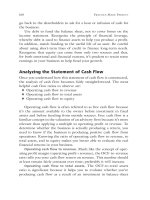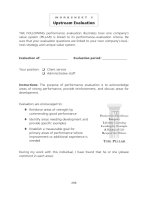Tài liệu Practice Made Perfect 15 ppt
Bạn đang xem bản rút gọn của tài liệu. Xem và tải ngay bản đầy đủ của tài liệu tại đây (130.76 KB, 10 trang )
118 PRACTICE MADE PERFECT
mission-based pay is essentially variable base pay. Like fixed base
pay, commission-based pay is the amount an individual gets paid for
doing his or her job. The more an individual’s performance is tied to
revenue generation, the more contingent on short-term variables that
person’s pay should be. The more an individual’s role is related to
processes or administration, the more fixed his or her compensation
should be. But there are variations on these themes, depending on
the type of culture and organization you’re trying to create.
Bonuses and Incentives
A bonus or incentive is an amount over and above base pay that
should be awarded when the business or individual achieves certain
milestones or exceeds expectations. Too many advisory firms pay a
bonus, rather than an incentive. A bonus is usually a surprise; it
is not typically tied to any measurable expectation and tends to be
discretionary. An incentive, on the other hand, links performance
and behavior to the pay. It’s important when setting up incentive
programs to measure and reward the right types of performance and
not merely achievement of the ordinary or expected.
In compensating a professional adviser, it’s typical to have some
amount of compensation “at risk”—incentive pay based on the per-
formance of either the firm or the individual (or both). The theory
is that incentive pay motivates a certain kind of behavior (determined
FIGURE 7.1 Compensation Components
Base Pay
Short-Term
Incentives
Perquisites
Long-Term
Wealth
Building
Employee
Benefits
Base Pay
Short-Term
Incentives
Long-Term
Wealth
Building
Perquisites
Employee
Benefits
Source: © Moss Adams LLP
THE PAYOFF FOR THE FIRM: COMPENSATION PLANNING 119
by how you structure the incentive plan) and that incentive pay
allows you to strike the desired balance of risk between the profes-
sionals and the organization.
Most firms that do not have incentive pay omit it either by neglect
or because they do not know what to measure. In some cases, the
reluctance seems to stem more from the desire not to judge or distin-
guish one individual’s performance or contribution from another’s at
the risk of saying one is “better than” and the other is “worse than.”
Some firms are reluctant to say that one person’s skill set is more or
less valued than another’s, or that someone’s performance is better
or worse, or that someone’s contribution is bigger or smaller. This
kind of equanimity is not necessarily a bad idea; in fact, it’s core to
the culture at some firms. It will, however, affect the compensation
program design significantly.
The factors that would potentially drive an incentive program
are those things that matter to the organization, including but not
limited to:
! Individual job performance
! Firm performance
! Tenure
! Saturation of a target market
! Attainment of certifications or education
! Business-development responsibility
! Special contributions
Benefit Plans
Benefit plans are put in place by employers to support cash compen-
sation. They may include health insurance, disability and life insur-
ance, and 401(k) plans. These sweeteners in compensation are often
necessary to compete for talent, though small businesses must be
careful about trying to offer plans competitive with larger organiza-
tions that can afford to offer more.
Perquisites
Perquisites are also noncash benefits—for example, a club member-
ship or a car paid for by the business—that are usually conferred on
someone because of status. Senior staff people may get free parking.
120 PRACTICE MADE PERFECT
These benefits are often a hidden but substantial cost in small busi-
nesses and can distort profitability if not managed well.
Long-Term Wealth-Building Plans
These plans may be tied to long-term behavior and may include
options, partnership or other stock ownership, or even phantom
stock. Equity-type offerings should be reserved for individuals who
behave like owners and whose contributions to the business result in
enhanced value. Equity should never be given; it should always be
sold. It’s important for participants in these programs to have some
skin in the game.
Phantom stock and options, on the other hand, may be issued to
key people as a form of noncash compensation. In both cases, the
employees realize the benefit when the business is sold, or in some
cases, when they retire. Typically, these forms of equity protect the
current owners from income dilution and loss of ownership con-
trol and do serve a role in some practices. However, most advisory
firms should validate how important such synthetic equity is to the
employee compared with real ownership. In many cases, for example,
it’s not the idea of equity that’s so compelling but the ego fulfillment
that comes from saying, “I’m a partner.”
Establishing Base Compensation
Setting the base compensation can be a challenge. Should it be fixed
or variable? What is the person’s contribution, responsibility, experi-
ence? What does the market pay? Base compensation is the amount
an employee gets paid for doing his job. Such compensation can be
paid in essentially three ways:
! Fixed salary: Market-rate compensation, paid as a fixed base salary
! Commission: Pay for doing the job, commission is paid on a
variable basis instead of a fixed basis (a hybrid between base and
incentive compensation)
! Draw: Base pay for the job, calculated as a percentage of the
individual’s previous year’s total compensation
THE PAYOFF FOR THE FIRM: COMPENSATION PLANNING 121
The most common form of base pay—used in combination with
incentive pay or in isolation—is a fixed salary, which is the simplest
and most “firm-oriented” of the above options. The process of
establishing base pay should take into consideration:
! The job description and responsibilities
! Market compensation benchmarks as a baseline
! Adjustments to market-rate compensation based on the indi-
vidual’s experience, tenure, and designations, as well as on
affordability to the firm
! Annual reviews and adjustments based on changing responsibili-
ties or expectations
This process, of course, begs the question, What is market-rate
compensation?
Benchmarking Compensation
One benchmark that owners of advisory practices often ask us to
consider in our compensation studies is a job title’s market rate—
defined as what the individual could earn working elsewhere, given
geography, experience, and expertise. Perhaps a better way to think
of market rate is not in terms of what the employee could make
elsewhere but in terms of what it would cost to hire someone else to
perform the employee’s job. This is typically the best way to exam-
ine market rate, by asking not “What is the candidate worth?” but
rather “What is the job worth?” and “What is this candidate worth
in this job?”
Compensation benchmarks for jobs in financial-advisory firms are
hard to come by, particularly for relationship-manager and senior-
adviser positions. The biannual FPA Compensation and Staffing
Study provides benchmarks unique to this market for a wide variety
of job functions. Figure 7.2 is an example of a detailed table for the
paraplanner position from the 2003 study. Worksheet 6 in the appen-
dix describes how to interpret these detailed tables, specifically, and
presents some questions you should consider when evaluating any
compensation benchmarks or salary survey data.
We often apply market-rate information to a firm attempting to
align its compensation plan with its strategic plan. As a first step, to
122 PRACTICE MADE PERFECT
provide a composite, we pull together data from a variety of sources.
We try to observe industry data, local market factors, and national
industry factors in evaluating a position. Obviously, it’s important
that the position be defined clearly so that our comparisons are rel-
evant. The external benchmarks and internal affordability and job-
worth analysis will be used to define a salary range for each position
defined within the firm.
FIGURE 7.2
PARAPLANNER
Primary Function K
A technical position responsible for the detail work in developing modular or comprehen-
sive financial plans for clients in support of a relationship manager. Limited client contact
except in meetings, data gathering, and follow-up.
Number of positions reported: 267
% who are owners: 0.4
Median % ownership: 25.0
<
$250,000
$250,000– $500,000–
>$1,000,000 $500,000 $1,000,000
Positions reported, by firm revenue 10.5% 13.9% 24.3% 51.3%
Salary + Commission Ownership
Salary Only Incentive Only Distribution Combination No Data
Compensation method 43.1% 45.7% 0.0% 0.0% 6.0% 5.2%
Lower Upper
Compensation information:
Quartile Median Quartile
Base compensation $32,500 $38,000 $45,759
% reporting bonus 48.9%
Bonus $1,309 $3,000 $5,043
Median bonus, % median salary 7.9%
% reporting commissions 4.9%
Commissions $5,000 $10,000 $21,000
% reporting ownership distribution 0.4%
Ownership distribution $670 $670 $670
Total compensation $35,000 $40,000 $50,000
Factors impacting compensation:
Variance as a % of median base compensation
Lower Upper
Quartile Median Quartile
Experience (in years) 3 5 8
Variance in salary by work experience 89% 105% 139%
Tenure (in years) 1 3 5.75
Variance in salary by tenure 105% 97% 123%
THE PAYOFF FOR THE FIRM: COMPENSATION PLANNING 123
As a general rule, you do not want to start an individual’s com-
pensation at the upper level of the range because you have nowhere
to go once this salary is established, unless you want to violate your
guidelines or promote the person to another position. To decide into
which tier to place the person for base purposes, make a judgment
based on experience and credentials, financial contribution to the
firm, and responsibility. As the individual’s experience, credentials,
Source: © Moss Adams LLP
PARAPLANNER (continued)
CFP
CFP certificate holder 14.6%
Variance in salary if CFP certificant 111%
$250,000–
Population of local market
<$250,000 $1,000,000 $1,000,000+ No Data
% of positions reported by population 18.4% 23.3% 54.3% 4.0%
Variance in salary by population 83% 95% 105%
Most common secondary functions
No Secondary O N, Q Other
% reporting secondary function 49.8% 13.1% 6.4% 30.7%
Variance in salary by secondary function
As a % of median base compensation
100% 101% 89%
As a % of total compensation
100% 106% 94%
Full- vs. part-time:
Full-Time Part-Time No Data
% of positions reported 83.5% 15.7% 0.7%
Lower Upper
Quartile Median Quartile
Annual salary for part-time $19,500 $25,000 $30,000
124 PRACTICE MADE PERFECT
and contributions increase, he or she would be moved higher within
the range each year.
If practical, renew the survey and evaluate your pay range each
year, although every other year may be adequate in a normal mar-
ket. Your pay ranges will likely need to be adjusted for inflation
or cost of living (COLA) each year, if affordable. COLA amounts
during the past few years have ranged from 3 percent to 4 percent
in most markets. Changes in inflation or cost of living will be
reflected in changes to the range; changes in performance expec-
tations will be reflected by a change in the individual’s position
within the range. So it’s possible for an individual who does not
move up a tier to still receive an increase in base pay, depending
on changes in inflation.
Establishing an Incentive Compensation Plan
Whereas base pay is compensation for doing the job, incentive com-
pensation is pay for exceeding the expectations for the job. There are
essentially three different ways incentives can be paid:
! Incentive pay: Performance-based pay, earned by exceeding
defined personal or firm goals
! Bonus: Discretionary extra pay if the firm or individual does
well, although neither term is defined up front, and a bonus is
typically a surprise
! Profit sharing: Similar to incentive pay but tied solely to the
firm’s profitability goals, which may or may not be defined and
communicated up front
There is a difference between a bonus and an incentive. A bonus
is a surprise. An incentive is tied to some measurable expectation.
Although a Christmas bonus is not a bad thing in and of itself, you
will be disappointed if you expect it to drive behavior. It’s a gift; it’s
not incentive pay. There is room for either or both in a compensation
plan, but you need to be clear on how you’re paying, why you’re using
a given method, and what you expect it to accomplish. Incentive pay
that is tied to particular behavior will, by its very nature, be more
successful in motivating defined behavior.
THE PAYOFF FOR THE FIRM: COMPENSATION PLANNING 125
For an incentive plan to be effective, employees at every level need to
be able to fill in the blank: “If I/we do more of __________, I will make
more money.” If not everyone on the staff can answer that question,
the incentive plan is overcomplicated, ineffective, or nonexistent.
If an incentive plan is in place but is ineffective, one of the follow-
ing is typically at fault:
! The plan is not well matched to the firm’s style.
! The plan is sending conflicting messages.
! The plan is not understood by participants.
! There is too much or too little at risk.
! The performance measures or measurement systems are dys-
functional.
There are a number of steps to consider in designing an incen-
tive plan:
! What will be the role of incentive compensation in your over-
all plan?
! What is the desired balance between risk and reward, variable
and base pay?
! Who will be eligible and at what level?
! What kind of behavior are you trying to encourage?
! How will you evaluate and measure that behavior and perfor-
mance?
! Are you inclined toward team-based, individual-based rewards,
or both?
Before getting down to the mechanics of the plan, make sure you
understand the drivers and philosophy underlying it.
The Role of Incentive Compensation in the Overall Plan
Typically, the role incentive compensation plays in a total compensation
plan will vary by firm and usually by position within a firm. A number
of factors affect whether a position will be eligible for incentive pay and
what proportion of total compensation the incentive will represent:
! Relationship management (higher percentage variable pay) ver-
sus client service (lower percentage variable). Who is accountable
to the client?
126 PRACTICE MADE PERFECT
! Solving problems (higher percentage variable pay) versus analyz-
ing problems (lower percentage variable). What is the level and
nature of the work being performed?
! Revenue generation (higher percentage variable pay) versus facil-
itation of revenue generation (lower percentage variable). How
much influence does the person have on business development?
! Hard, quantitative measures (higher percentage variable pay)
versus soft, qualitative measures (lower percentage variable).
How is the position’s performance measured?
Those positions that have greater influence on the success of the
business typically have more compensation at risk—a higher incen-
tive portion—and also have greater upside potential. This is the
risk-reward relationship at work. An administrative position might
have 0–5 percent of total compensation as incentive, whereas a purely
business-development position might have 50–75 percent or more of
total compensation as incentive.
Determining Performance Measures
Incentive plans in the most successful firms are moving further away
from strictly revenue-based drivers and working to incorporate addi-
tional measures. Although personal productivity is still measured
and rewarded for professional positions in most firms, some addi-
tional performance measures driving compensation include:
! New clients in a target market
! Total firm revenue
! Revenue within a target market
! Revenue within a target product or service area
! Firm profitability
! Client satisfaction/client service
! Commitment to developing staff
! Events or milestones
! Special tasks or projects
We recommend having no more than five performance measures
or goals per position. It’s best to focus and emphasize the most
important factors and have those be the ones that affect incentive
THE PAYOFF FOR THE FIRM: COMPENSATION PLANNING 127
compensation directly. It’s also important that measures not be con-
flicting, too broad, or too difficult to measure or evaluate.
Communicating and Implementing the Plan
The most important thing to do first when communicating a new
incentive compensation plan is to communicate the underlying phi-
losophy. Even people who deliberately and carefully develop a plan
tend to get caught up in the mechanics when they describe how it
works. Before you start talking calculations and mechanics, make
sure that you’ve clearly described the philosophy the plan is built on
and how the plan relates to your overall business strategy.
Make sure that the participants in the plan will have ongoing
access to performance results and feedback on how they’re doing. If
you reach the end of the measurement period and the results are a
surprise to the participants, then the plan was not well administered
during that period. Make sure managers are trained in giving feed-
back and conducting meaningful performance appraisals.
Do not forget that even the best compensation plan in the world
will not allow you to relinquish active management.
The Role of Equity Participation
In addition to cash compensation in the form of base and incentive
pay and noncash compensation in the form of benefits and perqui-
sites, more advisory firms—particularly growing firms and those
with an eye on their own retirement and succession—are examining
the role of equity or other long-term wealth accumulation in the
overall compensation scheme.
Long-term wealth-building plans should be tied to long-term
behavior and should be reserved for those individuals who behave
like owners and whose contributions to the business result in
enhanced value. This ensures that you have the right people in the
ownership pool and that additional owners will enhance the existing
owners’ value rather than dilute it.
Equity participation may be real—in the form of options, part-
nership, or other stock ownership—or it may be in the form of phan-
tom stock. Real equity should always be sold, rather than given away,
and the criteria for becoming an owner should be well deliberated.









